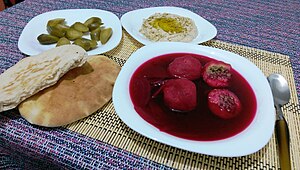 A bowl of red kubbeh in a beet broth. | |
| Alternative names | Kubbe, kubeh, chamo kubbeh, chamo kubbe, adom kubbeh, hamusta kubbeh |
|---|---|
| Type | Soup/dumpling |
| Course | Main dish |
| Place of origin | Iraq |
| Region or state | Mesopotamia |
| Serving temperature | Hot |
| Main ingredients | Coarse semolina, water, olive oil, salt, ground beef, vegetables |
| Variations | Kubbeh Khamo (yellow kubbeh), Kubbeh Khamusta (sour kubbeh), Kubbeh Adouma (red/beet kubbeh), Kubbeh Bamia (with okra and tomato paste), Kubbeh Za'atar (with hyssop and lemon juice). |
Kubbeh, also known as kubbe,[1][2] is a family of dishes of Iraqi Jewish, and Assyrian[1] origin that are also popular in the Levant, and consist of a filled dumpling soup, with a wide array of fillings and soup broths. Once almost exclusively made at home by members of the Iraqi and Assyrian communities, since the early 20th century the popularity of the dish has expanded to Israelis of all backgrounds. It is commonly served in restaurants across Israel, most notably in the Machane Yehuda market in Jerusalem.[3][4][5][6][7][8]
The term kubbeh is also used in some countries to refer to kibbeh, a type of paste made of bulgur and meat that is used in a variety of regional dishes.
- ^ a b Abdalla, Michael (1989). "Bulgur — An Important Wheat Product in the Cuisine of Contemporary Assyrians in the Middle East". Oxford Symposium on Food and Cookery: 27–37.
- ^ Walker, Harlan (1990). Staple foods: proceedings [of the] Oxford symposium on food and cookery 1989. Oxford symposium on food and cookery. London: Prospect books. ISBN 978-0-907325-44-4.
- ^ Lyons Bar-David, Molly (1964). The Israeli Cookbook: What's Cooking in Israel's Melting Pot.
- ^ Nathan, Joan. King Solomon's Table.
- ^ Solomonov, Michael. Israeli Soul. HMH.
- ^ Marks, Rabbi Gil. The Encyclopedia of Jewish Food.
- ^ Solomonov, Mike. Zahav. HMH.
- ^ "Marak kubbeh adom". Food52. Retrieved 7 January 2020.
© MMXXIII Rich X Search. We shall prevail. All rights reserved. Rich X Search
